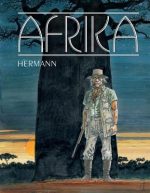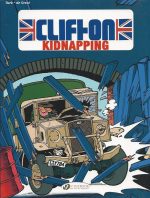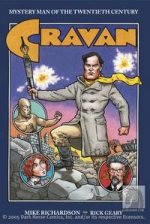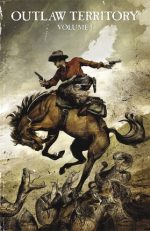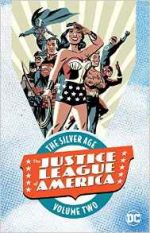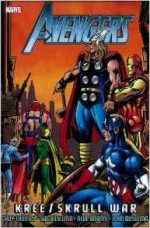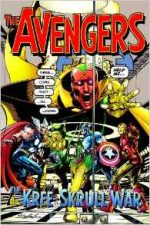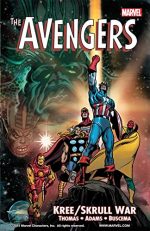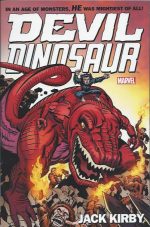
By Jack Kirby, Mike Royer & various (Marvel)
ISBN: 978-0-7851-9037-0
Jack Kirby was – and still is – the most important single influence in the history of American comics. There are millions of words about what the man has done and meant, and you should read those if you are at all interested in our medium.
Off course I’m going to add my own two-bobs’-worth, pointing out what you probably already know: Kirby was a man of vast imagination who translated big concepts into astoundingly potent and accessible symbols for generations of fantasy fans. If you were exposed to Kirby as an impressionable kid you were his for life. To be honest, the same probably applies whatever age you jump aboard the “Kirby Expressâ€â€¦
For those of us who grew up with Jack, his are the images which furnish and clutter our interior mindsets. Close your eyes and think “robot†and the first thing that pops up is a Kirby creation. Every fantastic, futuristic city in our heads is crammed with his chunky, towering spires. Because of Jack we all know what the bodies beneath those stony-head statues on Easter Island look like, we are all viscerally aware that you can never trust great big aliens parading around in their underpants and, most importantly, we know how cavemen dressed and carnosaurs clashed…
In the late 1930s it took a remarkably short time for Kirby and his creative partner Joe Simon to become the wonder-kid dream-team of the new-born comicbook industry. Together they produced a year’s worth of the influential monthly Blue Bolt, rushed out Captain Marvel Adventures (#1) for overstretched Fawcett and, after Martin Goodman appointed Simon editor at Timely Comics, co-created a host of iconic characters such as Red Raven, the original Marvel Boy, Mercury, Hurricane, The Vision, Young Allies and of course million-selling mega-hit Captain America.
When Goodman failed to make good on his financial obligations, Simon & Kirby were snapped up by National/DC, who welcomed them with open arms and a fat chequebook. Bursting with ideas the staid company were never really comfortable with, the pair were initially an uneasy fit, and were given two moribund strips to play with until they found their creative feet: Sandman and Manhunter.
They turned both around virtually overnight and, once established and left to their own devices, switched to the “Kid Gang†genre they had pioneered at Timely. Joe and Jack created wartime sales sensation Boy Commandos and a Homefront iteration dubbed the Newsboy Legion before being called up to serve in the war they had been fighting on comicbook pages since 1940.
Once demobbed, they returned to a very different funnybook business and soon left National to create their own little empire…
Simon & Kirby heralded and ushered in the first American age of mature comics – not just by inventing the Romance genre, but with all manner of challenging modern material about real people in extraordinary situations – before seeing it all disappear again in less than eight years.
Their small stable of magazines – generated for the association of companies known as Prize, Crestwood, Pines, Essenkay and/or Mainline Comics – blossomed and as quickly wilted when the industry abruptly contracted throughout the 1950s.
After years of working for others, Simon & Kirby had finally established their own publishing house, producing comics for a far more sophisticated audience, only to find themselves in a sales downturn and awash in public hysteria generated by an anti-comicbook pogrom.
Hysterical censorship-fever spearheaded by US Senator Estes Kefauver and opportunistic pop psychologist Dr. Frederic Wertham led to witch-hunting Senate hearings. Caving in, publishers adopted a castrating straitjacket of draconian self-regulatory rules. Horror titles produced under the aegis and emblem of the Comics Code Authority were sanitised and anodyne affairs in terms of Shock and Gore, even though the market’s appetite for suspense and the uncanny was still high. Crime comics vanished and mature themes challenging an increasingly stratified and oppressive society were suppressed…
Simon quit the business for advertising, but Jack soldiered on, taking his skills and ideas to a number of safer, if less experimental, companies. As the panic abated, Kirby returned briefly to DC Comics where he worked on mystery tales and Green Arrow (at that time a mere back-up, page-filler in Adventure Comics and World’s Finest Comics) whilst concentrating on his long-dreamed-of newspaper strip Sky Masters of the Space Force.
During that period Kirby also re-packaged an original super-team concept that had been kicking around in his head since he and Joe Simon had closed their innovative, ill-timed ventures. At the end of 1956 Showcase #6 premiered the Challengers of the Unknown…
After three more test issues they won their own title with Kirby in command for the first eight. Then a legal dispute with Editor Jack Schiff exploded and the King was gone…
He found fresh fields and an equally hungry new partner in Stan Lee at the ailing Atlas Comics outfit (which had once been mighty Timely) and there created a revolution in superhero comics storytelling…
After a decade of never-ending innovation and crowd-pleasing wonderment, Kirby felt increasingly stifled. His efforts had transformed the little publisher into industry-pioneer Marvel but now felt trapped in a rut. Thus he moved back to DC for another burst of sheer imagination and pure invention.
Kirby always understood the fundamentals of pleasing his audience and strived diligently to combat the appalling state of prejudice about the comics medium – especially from industry insiders and professionals who despised the “kiddies world†they felt trapped in.
After his controversial, grandiose Fourth World titles were cancelled, Kirby looked for other concepts which would stimulate his own vast creativity yet still appeal to a market growing ever more fickle. His follow-ups included science fiction themed heroes Kamandi and OMAC, supernatural star The Demon, a run of war stories starring The Losers, and even a new Sandman co-created with old Joe Simon, but although the ideas kept coming (Atlas, Kobra, Dingbats of Danger Street), yet again editorial disputes ended up with him leaving for promises of more creative freedom elsewhere…
Jack Kirby’s return to Marvel in 1976 was much hyped at the time but again turned out to be controversial. His new works and creations (2001: A Space Odyssey, The Eternals, Machine Man, Devil Dinosaur,) found friends rapidly, but his return to earlier creations Captain America and Black Panther divided the fanbase.
Kirby was never slavishly wedded to tight continuity, and preferred, in many ways, to treat his stints on titles as another “Day Oneâ€: a policy increasing at odds with the close-continuity demanded by a strident faction of the readership…
Devil Dinosaur is possibly his most divisive creation: sheer anathema to those fans who scrupulously policed the Marvel Universe, perpetually seeking out infractions to the holy writ and demanding “does this fit in?†They were apparently blind to the unfettered, joyous freedom of imagination run wild, the majesty of pulse-pounding thrills and electrically galvanising BIG ART!
For 25 years I taught comics-creation skills and techniques to pre-schoolers through to college graduates and let me tell you, nothing caused more heated debate amongst the adults and generated greater sheer, open-eyed, awestruck glee from the kids.
It’s a monkey man, riding a big red dinosaur, fighting monsters and aliens, for Pete’s sake!
And that is the reason this collection is so welcome. Jack’s commitment to wholesome adventure, breakneck action and breathless wonderment combined with his absolute mastery of the comic page and unceasing quest for the Next Big Thrill make for a captivating read. His comics should be on every School Curriculum if we want youngsters to get into Graphic Narrative…
Collecting the entire 9-issue run from April to December 1978, this sleek paperback chronicle begins with ‘Devil Dinosaur and Moon-Boy’ as we are taken back to an unspecified time in Earth’s prehistory where various emergent species of hominids eke out a perilous existence beside the last of the great lizards and other primordial giants…
In that perilous world a wide-eyed innocent of the timid but clever Small Folk rescues a baby tyrannosaur from humanoid hunters known as the Killer-Folk. They have already slaughtered its mother and siblings with cunning snares and now torture the little lizard with blazing firebrands which turn its scorched hide a livid, blazing red…
Under the roaring light of a blazing volcano Moon Boy and Devil bond; becoming inseparable companions wandering the vast lush valley which is their home.
The scarlet saurian is no ordinary beast. Blessed with uncanny intelligence and unmatchable ferocity, it soon becomes an equal partner in a relationship never before seen in the world. That does not, however, prevent the duo becoming targets for the ambitious new chief of the Killer-Folk.
Arrogant Seven-Scars wants to be undisputed master of the valley and has devised a lethal scheme with deadly traps to destroy the red terror and its feeble pet…
Sadly for them, the Killer-Folks’ schemes ensnare trusting Moon Boy but his scaly brother is not fooled and ‘Devil’s War!’ soon proves who truly rules in the dawn age…
Issue #3 concentrates on the sheer variety of humanoid life as ‘Giant’ pits our heroes against a monumental man-thing frenziedly hunting for his missing offspring, after which terror descends upon all when bizarre and merciless strangers erupt out of an ‘Object from the Sky’…
We’d call them robotic aliens but the only certainty the assorted Earth creatures know is that the monsters are coldly hostile butchers. When the newcomers snatch up Moon Boy amongst their many specimens, the wily crimson colossus strikes up a tenuous alliance with Hill Folk survivors Stone-Hand and his aging mentor White Hairs before leading them in a terrifying ‘Journey to the Center of the Ants!’
Intent on using giant termites to invade the alien ship, the strange bedfellows encounter yet another frantic fugitive in the form of furious female ‘Eev!’; allowing Kirby to set up a telling biblical pastiche of the Garden of Eden…
After the termite-wave eradicates the invading metal ship, all that remains is a semi-autonomous computer system the natives deem a ‘Demon-Tree!’ The fancy-speaking thing seduces Stone-Hand, White Hairs and Eev into an idyllic preserve where it grants their every wish, but its increasingly harsh mandates soon make the hominids realise they are prisoners, not guests…
Happily, Devil and freshly-liberated Moon Boy are on hand to offer some destructive assistance…
Having gone back to their inquisitive wanderings, mammal and reptile soon find more peril when Devil is targeted by anthropoid ‘Dino-Riders!’ who want the mighty lizard for their greatest beast of burden. This time it’s Moon who does the saving, but only after convincing his meek Small Folk brethren to unite against their mutual beast-piloting oppressors…
The last issue is certainly the most intriguing as ‘The Witch and the Warp’ sees Devil fall into a naturally-occurring space-time fault seemingly controlled by a peculiar hag and her quirky disciple.
It takes all Moon Boy’s persuasiveness to get her to bring the beast home again, and even after the friends are reunited Devil has no way of relating the details of his shocking adventure in Nevada, circa 1978 AD…
With extras including a complete cover gallery by Kirby, and inkers Royer, Frank Giacoia, Dan Green, Joe Sinnott, Steve Leialoha, Walter Simonson and John Byrne, plus a selection of house ads, editorials by Kirby and ‘Dinosaur Dispatches’ letters columns from the period, this compilation is a dose of utter, uncomplicated comics magic: bold, brash, and completely compelling. How can you possibly resist the clarion call of sheer eccentric escapism?
© 1978, 2014 Marvel Characters, Inc. All rights reserved.
